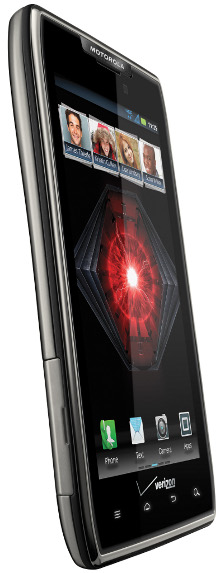Droid Razr Maxx is ‘longest-lasting’ smartphone
Jan 26, 2012 — by LinuxDevices Staff — from the LinuxDevices Archive — 1 viewsVerizon is now offering Motorola's Droid Razr Maxx for $300, with a claimed battery life of up to 21 hours. With a dual-core, 1.2GHz processor, 4.3-inch screen, and an eight megapixel camera, the device is otherwise similar to the previously released Droid Razr, but it's thicker by approximately 2mm.
 The Droid Razr Maxx (pictured) is now available on the Verizon Wireless network for $300, after being announced with minimal detail at CES earlier this month. Motorola's answer to the "but" that followed otherwise-positive reviews of its relatively new Droid Razr, the Razr Maxx is said to feature a battery life of up to 21 hours on a single charge, making it the longest-lasting smartphone on the market.
The Droid Razr Maxx (pictured) is now available on the Verizon Wireless network for $300, after being announced with minimal detail at CES earlier this month. Motorola's answer to the "but" that followed otherwise-positive reviews of its relatively new Droid Razr, the Razr Maxx is said to feature a battery life of up to 21 hours on a single charge, making it the longest-lasting smartphone on the market.
All those positive reviews should work in the Razr Maxx's favor, as it's equipped with all the same features as the Droid Razr, though in not as slim a form factor. Given the ruler treatment, the Droid Razr comes in at 7.1mm thick, while the Razr Maxx measures 8.99mm and the iPhone 4S 9.3mm.
Further filling out the Maxx's resume are its dual-core, 1.2GHz processor and compatibility with Verizon's super-quick 4G Long Term Evolution (LTE) network.
The Razr Maxx runs Android 2.3.5 Gingerbread, but is upgradable to 4.0 ("Ice Cream Sandwich"). It features a 4.3-inch AMOLED HD touchscreen, an eight-megapixel rear-facing camera with 1080p HD video capture, and a front-facing camera for video chatting over 4G, 3G, or Wi-Fi.
The Maxx can enable up to eight Wi-Fi-enabled devices to hop on Verizon's 4G network, comes with 32GB of memory and — asking to be taken to work — features remote-wipe capabilities and government-grade encryption.
Knowing what the Razr Maxx is up against, Motorola created "Smart Actions" as a sort of next best thing to Apple's Siri. With the former, the phone can be made helpful in certain rules-based ways, such as launching Google Maps when the user is in the car.
Customers who purchase the Razr Maxx will need to subscribe to Verizon's Nationwide Talk plan, which begins at $40 a month, and purchase a smartphone data package, which starts at $30 a month.
"We are a premium-priced product, but we will win in the marketplace. …. There are niches of people that want to be on the best network in the world," Verizon CFO Fran Shammo told analysts during a Jan. 24 call on the carrier's 2011 fourth-quarter results.
Despite pulling in $28.4 billion in revenue and selling more than twice the number of iPhones than it did the quarter before — 4.2 million Apple handsets, up from 2 million — Verizon finished at a loss of $2.02 billion. The two main contributors to its fall to red were pension costs, which it had warned investors of in advance, and the high cost of supporting the iPhone.
Verizon's incremental spending during the quarter was up 6.3 percent, Shammo said, due to a combination of "3G capacity requirements, driven by the Apple iPhone, and the continued rapid expansion of our 4G LTE network."
The price Apple charges the carriers for each iPhone also forces them to pay a higher subsidy than with any other handset, in order to offer the iPhone to consumers at a price competitive with their other handsets. But as the iPhone is a device users switch carriers for, and iPhone users are said to be the most lucrative customers over the long term, Verizon and its competitors find the iPhone's initial right hook worth suffering.
Michelle Maisto is a writer for eWEEK.
This article was originally published on LinuxDevices.com and has been donated to the open source community by QuinStreet Inc. Please visit LinuxToday.com for up-to-date news and articles about Linux and open source.